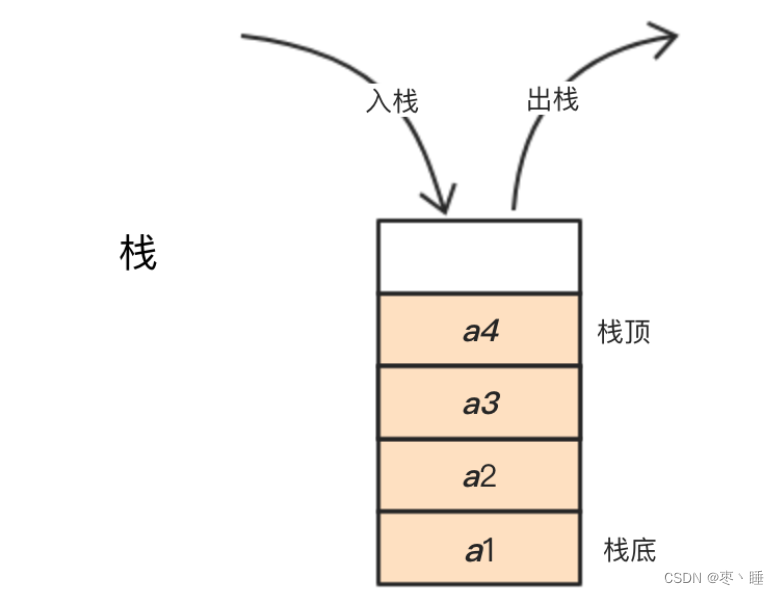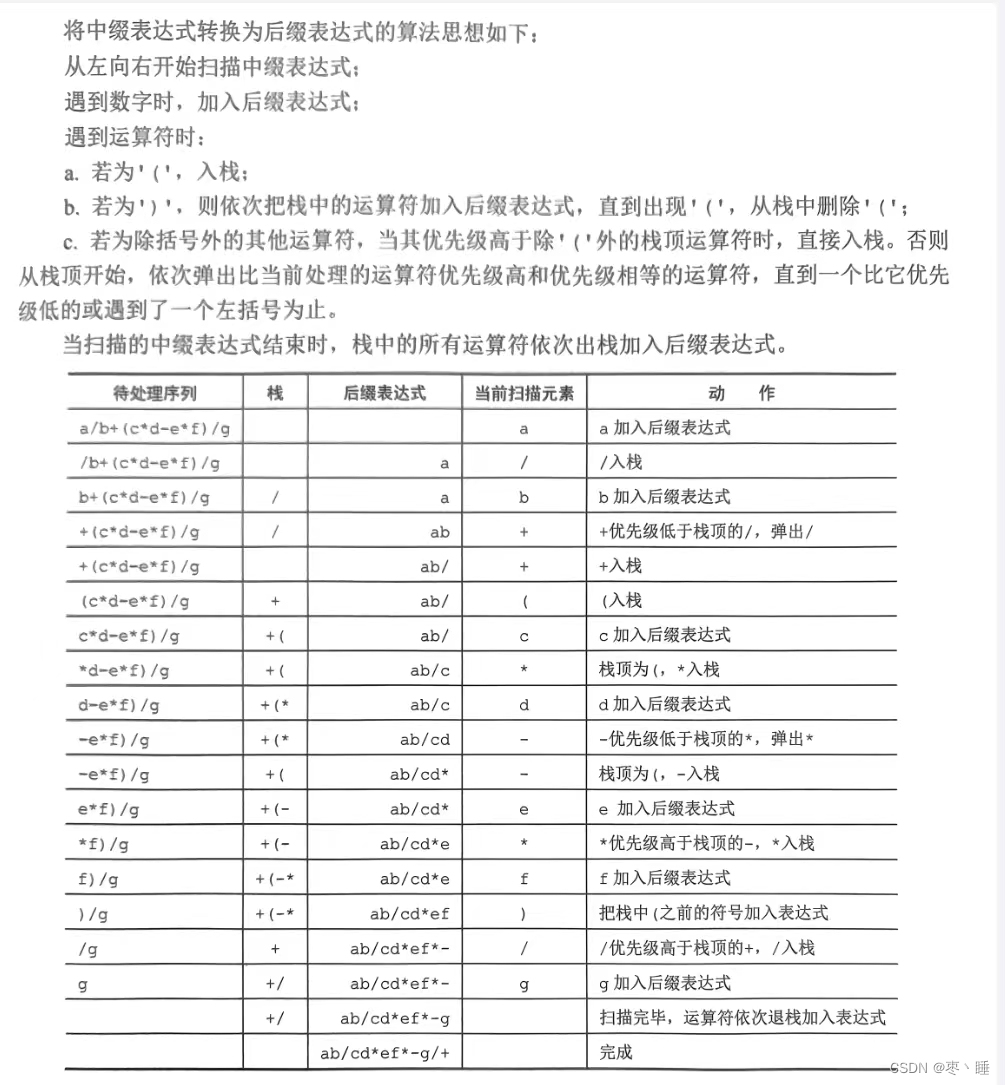目录
一、栈的基本概念
1.栈的定义


2.栈的基本操作
// 初始化栈
void StackInit(Stack* ps);
// 入栈
void StackPush(Stack* ps, STDataType data);
// 出栈
void StackPop(Stack* ps);
// 获取栈顶元素
STDataType StackTop(Stack* ps);
// 获取栈中有效元素个数
int StackSize(Stack* ps);
// 检测栈是否为空,如果为空返回非零结果,如果不为空返回0
bool StackEmpty(Stack* ps);
// 销毁栈
void StackDestroy(Stack* ps);二、栈的顺序存储结构
1.顺序栈定义
采用顺序存储的栈称为顺序栈,它利用一组地址连续的存储单元存放自栈底到栈顶的数据元素,同时附设一个指针(top),指示当前栈顶元素的位置(或当前栈顶元素的下一个位置)。
栈的顺序存储类型可描述为:
typedef int STDataType;
typedef struct Stack
{
STDataType* pst;
int top;
int capacity;
}Stack;
2.顺序栈实现(top指针指向栈顶元素下一个位置)
注:当top指针指向栈顶元素下一个位置时,栈为空,top指针初始化为0
若top指针指向栈顶元素,则栈为空时,top初始化为-1
// 初始化栈
void StackInit(Stack* ps)
{
ps->pst = NULL;
ps->top = 0;//指向栈顶元素后面
ps->capacity = 0;
}
// 入栈
void StackPush(Stack* ps, STDataType data)
{
assert(ps);
if (ps->top == ps->capacity)
{
int newCapacity = ps->capacity == 0 ? 4 : ps->capacity * 2;
STDataType* tmp = (STDataType*)realloc(ps->pst, newCapacity*sizeof(STDataType));
if (tmp == NULL)
{
perror("realloc fail");
return;
}
ps->pst = tmp;
ps->capacity = newCapacity;
}
ps->pst[ps->top] = data;
ps->top++;
}
// 出栈
void StackPop(Stack* ps)
{
assert(ps);
assert(!StackEmpty(ps));//确保栈不为空
ps->top--;
}
// 获取栈顶元素
STDataType StackTop(Stack* ps)
{
assert(ps);
int top = ps->top;
return (ps->pst)[top-1];
}
// 获取栈中有效元素个数
int StackSize(Stack* ps)
{
assert(ps);
return ps->top;
}
// 检测栈是否为空
bool StackEmpty(Stack* ps)
{
assert(ps);
if (ps->top == 0)
{
return true;
}
return false;
}
// 销毁栈
void StackDestroy(Stack* ps)
{
assert(ps);
free(ps->pst);
}3.共享栈(知识漏洞)
利用栈底位置相对不变的特性,可让两个顺序栈共享一个一维数组空间,将两个栈的栈底分别设置在共享空间的两端,两个栈顶向共享空间的中间延申。
 、
、
(1)两个栈的栈顶指针都指向栈顶元素,top0=-1时,蓝色栈为空;top1=MaxSize时,绿色栈为空;
(2)仅当两个栈栈顶指针相邻(top1-top0==1)时,判断栈满。
(3)当蓝色栈进栈时,top0先+1,再赋值,绿色栈进栈时top1先-1,再赋值;出栈时相反
(目的是先判断有没有空间再确定是否赋值,防止覆盖掉或删掉原有数据)
优点:共享栈是为了更有效的利用储存空间,两个栈的空间相互调节,只有在整个储存空间被占满
时才发生上溢,其存取数据的时间复杂度均为O(1),所以对存取效率没有影响。
三、栈的链式存储结构
1.链式栈定义
采用链式存储的栈称为链栈。、
优点是便于多个栈共享存储空间和提高其效率,且不存在栈满上溢的情况。
typedef int DataType;
typedef struct StackNode
{
DataType date;
struct StackNode* next;
}SNode;
typedef struct ListStack
{
int capacity;
SNode* top;
}LStack;2.链式栈实现
注:通常采用单链表实现,并规定所有操作都在单链表表头进行,这里规定链栈没有头结点
SNode* BuyNode(DataType x)
{
SNode* node = (SNode*)malloc(sizeof(SNode));
if (node == NULL)
{
perror("malloc fail");
return NULL;
}
node->date = x;
node->next = NULL;
return node;
}
// 初始化栈
void StackInit(LStack* ps)
{
ps->capacity = 0;
ps->top = NULL;
}
// 入栈
void StackPush(LStack* ps, DataType data)
{
assert(ps);
SNode* node = BuyNode(data);
//栈为空
if (StackEmpty(ps))
{
ps->top = node;
ps->capacity++;
}
//栈不为空
//此时top指向头结点,此时插入就是单链表头插
else
{
node->next = ps->top;
ps->top = node;
ps->capacity++;
}
}
// 出栈
void StackPop(LStack* ps)
{
assert(ps);
assert(!StackEmpty(ps));
//单链表头删
SNode* tmp = ps->top;
ps->top = ps->top->next;
free(tmp);
ps->capacity--;
}
// 获取栈顶元素
DataType StackTop(LStack* ps)
{
assert(!StackEmpty(ps));
return ps->top->date;
}
// 获取栈中有效元素个数
int StackSize(LStack* ps)
{
return ps->capacity;
}
// 检测栈是否为空
bool StackEmpty(LStack* ps)
{
return ps->top == NULL;
}
// 销毁栈
void StackDestroy(LStack* ps)
{
assert(ps);
while (!StackEmpty(ps))
{
StackPop(ps);
}
ps->top = NULL;
}四、栈的应用
1.括号匹配

思路:
第一步:依次遍历字符串,如果是左部分括号,依次入栈,
如果遇到右部分括号,若栈为空,则无效括号,若与栈顶元素匹配,则栈顶元素出栈
第二步:遍历完字符串后判断栈是否为空,如果栈为空,则括号一一匹配,有效,否则无效
第三步:释放内存
LStack st;
bool isValid(char * s){
StackInit(&st);
while(*s)
{
if(*s=='('
|| *s=='['
|| *s=='{')
{
StackPush(&st,*s);
}
else
{
if(StackEmpty(&st))
{
StackDestroy(&st);
return false;
}
char c=StackTop(&st);
//printf("%c",c);
if(c=='(')
{
if(*s!=')')
{
StackDestroy(&st);
return false;
}
}
else if(c=='[')
{
if(*s!=']')
{
StackDestroy(&st);
return false;
}
}
else if(c=='{')
{
if(*s!='}')
{
StackDestroy(&st);
return false;
}
}
StackPop(&st);
}
s++;
}
if(!StackEmpty(&st))return false;
StackDestroy(&st);
return true;
}2.栈在表达式求值中的应用

注:后缀表达式先出栈的是右操作数
前缀表达式先出栈的是左操作数
中缀表达式转化为后缀表达式思路(知识漏洞):

3.栈实现队列

思路:由于一组序列入栈再出栈会使序列倒序输出,而队列先进先出,则不会改变序列
所以利用一个栈作为inStack输入数据,输出的数据先进入outStack,再由outStack输出。
typedef struct {
Stack stIn;
Stack stOut;
} MyQueue;
MyQueue* myQueueCreate() {
MyQueue* que=(MyQueue*)malloc(sizeof(MyQueue));
StackInit(&que->stIn);
StackInit(&que->stOut);
return que;
}
void myQueuePush(MyQueue* que, int x) {
StackPush(&que->stIn,x);
}
int myQueuePop(MyQueue* que) {
if(StackEmpty(&que->stOut))
{
while(!StackEmpty(&que->stIn))
{
StackPush(&que->stOut,StackTop(&que->stIn));
StackPop(&que->stIn);
}
}
if(StackEmpty(&que->stOut))
{
return -1;
}
int x=StackTop(&que->stOut);
StackPop(&que->stOut);
return x;
}
int myQueuePeek(MyQueue* que) {
int x=myQueuePop(que);
StackPush(&que->stOut,x);
return x;
}
bool myQueueEmpty(MyQueue* que) {
if(StackEmpty(&que->stIn)&&StackEmpty(&que->stOut))
{
return true;
}
return false;
}
void myQueueFree(MyQueue* que) {
StackDestroy(&que->stOut);
StackDestroy(&que->stIn);
free(que);
}

























 被折叠的 条评论
为什么被折叠?
被折叠的 条评论
为什么被折叠?










